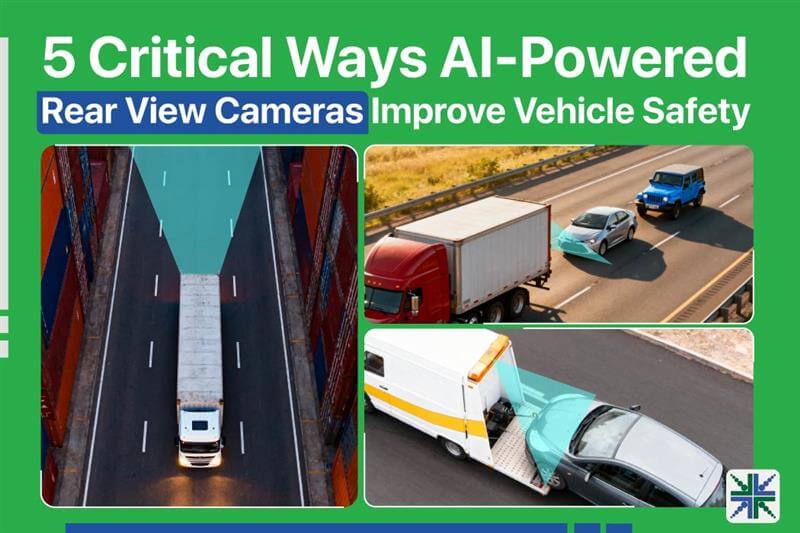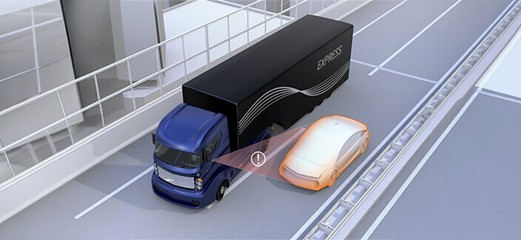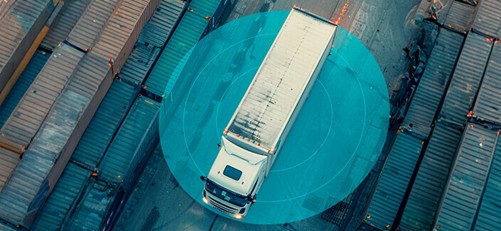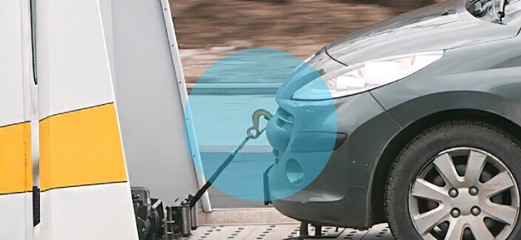What you’ll discover in this blog:
- What AI-powered rear view cameras contribute to vehicle safety?
- How imaging features like HDR, wide FoV, and high sensitivity provide visuals for AI analytics
- Importance of rear view vision systems for fleet safety and driver assistance
- How camera integration improves decision-making speed and reduces accident risks
Rear view cameras have been part of vehicle safety for years. But the rise of AI-driven imaging has changed what these systems can do. Rear cameras now act as smart vision nodes for recognizing patterns, detecting movement, and guiding drivers with real-time visual intelligence.
It matters most in transport, logistics, construction, and public safety fleets, where maneuvering room is limited and operational downtime carries real cost. AI-enabled rear view cameras improve awareness and reduce reaction time, making each reverse, lane shift, or trailer hitch more controlled.
In this blog, you’ll get to know the top rear view camera features for vehicular safety and the major advantages of using them.
Key Features of AI-Powered Rear View Cameras
High Dynamic Range (HDR)
HDR technology stabilizes visibility during sudden light transitions such as moving from bright sunlight into shaded docks or dim tunnels. It eliminates glare and shadow loss that can distort visual inputs. With balanced exposure, AI models gain consistent image quality to identify pedestrians, vehicles, and objects accurately under complex lighting. The result is faster decision-making and less false detection during movement or parking.
Wider Field of View (FoV)
A wide-angle lens captures a larger area behind and beside the vehicle, covering blind corners and lateral traffic movement. The broader perspective gives AI systems better context to interpret distance, depth, and motion paths. It enables simultaneous tracking of pedestrians, vehicles, and stationary assets across multiple zones, supporting safer reversing and maneuvering in tight operational spaces.
High sensitivity
High-sensitivity enhances visibility in dim or variable lighting such as nighttime yards, underground parking areas, or stormy weather. They capture fine details that standard sensors overlook, improving object differentiation for AI analysis. Consistent low-light performance ensures reliable detection and classification across every shift, protecting assets and personnel even under minimal illumination.
Rugged enclosure
Automotive-grade housings protect internal components from vibration, debris, moisture, and pressure cleaning. Their durability ensures the camera remains stable and operational throughout demanding conditions. Continuous visual input enables AI algorithms to sustain accurate inference and event tracking over long duty cycles, reducing downtime and maintenance frequency in fleet and industrial applications.
Top 5 Vehicle Safety Benefits of AI-Powered Rear View Cameras
Blind spot detection
AI-powered rear cameras monitor peripheral zones that drivers often cannot see. They help the system prevent side swipes and backing incidents by recognizing nearby vehicles, walls, or objects entering the rear quarter area. It can be very useful in narrow job sites or multi-lane traffic scenarios.
- Supports lane-change decision-making when mirrors provide limited visibility
- Detects objects approaching from the rear corners during turn exits or merges
- Can reduce insurance claims caused by low-speed side contact in dense traffic
Safe reversing
Large vehicles reversing without proper imaging data create a lot of risk. With rear cameras providing depth awareness and object recognition, drivers can back into docks or yards with higher control. Moreover, AI models distinguish between stationary and moving objects, reducing reliance on mirrors or spotters.
- Deliver clear visuals even in loading areas with poor lighting or uneven terrain
- Reduce vehicle downtime caused by misjudged docking or obstacle impact
- Support alerts that help drivers adjust speed when closing in on rear hazards
 360-degree surround view
360-degree surround view
When integrated into a multi-camera system, the rear view unit contributes to a stitched 360-degree feed that enhances awareness around the entire vehicle. The panoramic perspective supports parking, turn navigation, and clearance checks while also assisting during moving-off scenarios where rear visibility is limited. For instance, a camera-based Moving Off Information System (MOIS) is placed at the front or back of heavy vehicles to detect obstacles hidden in blind spots. For example, in buses, it helps identify objects directly in front and low to the ground that drivers cannot easily see. It gives real-time spatial context to drivers or autonomous systems for detecting obstacles/pedestrians before acceleration.
- Enhance coordination with spotters or autonomous platforms during low-speed or moving-off maneuvers
- Help reduce driver strain by combining multiple angles into one unified visual stream
- Improve positioning accuracy in narrow industrial corridors and congested urban spaces
- Strengthen pedestrian detection and collision prevention during initial vehicle movement
Trailer hitching assistance
Aligning a vehicle with a trailer hitch requires exact movement, especially under time pressure or low visibility. AI-enabled rear cameras analyze distances and positioning, guiding the vehicle toward the coupling point without guesswork or manual correction.
- Save time during repeated coupling and decoupling cycles in fleet operations.
- Reduce mechanical wear by improving alignment precision before contact
- Lower driver training requirements by making hitching tasks more intuitive
Pedestrian detection near loading zones
AI models trained on human outlines and movement patterns help rear view cameras detect pedestrians behind the vehicle. It is critical during loading and unloading in shared workspaces where people and equipment move in close quarters.
- Assist with compliance in regulated work zones where human presence is high
- Enable logging of near-miss events for incident review and safety reporting
- Help prevent injuries in cluttered spaces with limited rear clearance
e-con Systems’ Rear View Cameras Ensure Vehicle Safety
Since 2003, e-con Systems has been designing, developing, and manufacturing OEM cameras. Our rear view cameras combine HDR, wide-angle imaging, and low-light performance inside rugged enclosures that withstand real-world vehicle deployment.
They work with embedded processors like NVIDIA Jetson, enabling AI-driven perception right at the edge. From blind spot coverage to pedestrian recognition, our cameras effortlessly meet the demands of on-road and off-road vehicle operations.
Go to our Camera Selector Page to view our full portfolio.
Building a rear view system for your mobility platform? Reach out to our experts at camerasolutions@e-consystems.com to find the perfect camera.
Frequently Asked Questions
- How does HDR improve the performance of rear view cameras?
HDR balances bright and dark areas in a single frame, making it easier to see obstacles when moving between sunlit roads and shaded zones. It keeps the video feed usable during sharp lighting transitions.
- Can AI-powered rear cameras detect moving objects?
Yes. AI models can track movement and distinguish between static objects and moving hazards, such as pedestrians, vehicles, or forklifts, especially during reversing or docking.
- What makes a camera suitable for outdoor vehicle mounting?
A rugged housing with IP-rated protection shields the camera from water, dust, vibration, and pressure washing. It ensures long-term durability on trucks, buses, and utility vehicles.
- Is a wide Field of View always better for rear view systems?
A wide Field of View helps cover more area behind the vehicle, including adjacent lanes and corners. However, the lens and sensor must be tuned to avoid distortion and maintain clarity at the edges.
- Can e-con Systems’ cameras integrate with in-vehicle AI systems?
Yes. e-con Systems’ rear view cameras are developed for edge computing platforms like NVIDIA Jetson. This setup enables AI models to run directly on the vehicle for real-time detection and decision-making.

Suresh Madhu is the product marketing manager with 16+ years of experience in embedded product design, technical architecture, SOM product design, camera solutions, and product development. He has played an integral part in helping many customers build their products by integrating the right vision technology into them.







